Origin Genesis Review: Triple Titan Terror
by Ryan Smith on April 23, 2013 9:00 AM ESTTitan Tri-SLI In-Depth: Letting Titan Spread Its Wings
Having taken a quick look at overall system performance, it’s time to get down to the real meat and potatoes of this review and of the Genesis’ existence: gaming.
The Genesis fundamentally exists for two reasons: you’re either playing on a triple monitor 2D/3D surround setup, or you’re playing Crysis 3. There is simply no other scenario where three Titan cards are necessary, as we’ll see. Genesis was meant to play games, and it was meant to do so at the highest resolutions with the highest settings; no compromise gaming at its finest.
To illustrate this point, we’ve run our Genesis system with 1, 2, and 3 Titan cards enabled to look at not only what its shipping performance is, but what scaling is like from 1 GPU to multiple GPUs. As we’ve discussed before, using multiple GPUs is not a foolproof way to improve performance due to the inherent limitations of AFR, but when we’re up to a single Titan card this is the only way to further improve performance.
We’re also throwing in numbers from our GPU testbed, where available. Since we can’t control for the differences in the testbed (not the least the cooling differences) we can’t hold the two of them equal. But we can at least showcase the difference between our testbed and the Genesis due to configuration, cooling, and CPU differences.
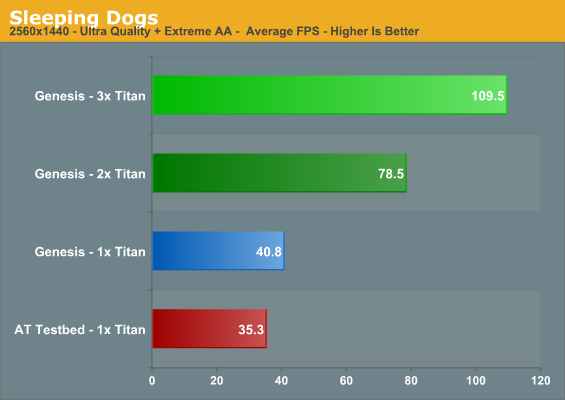
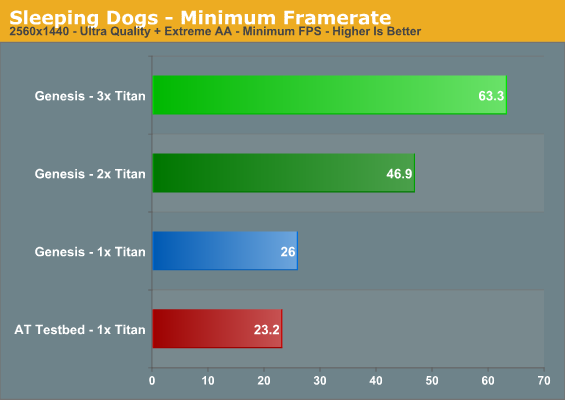
Sleeping Dogs’ benchmark doesn’t work correctly at 5760, so we’re stuck looking at 2560x1440 here. But even so it presents an interesting case study since Sleeping Dogs’ highest settings involve super-sample anti-aliasing nearly the entire screen, a performance-brutal but very effective method of eliminating jaggies. 1 Titan can’t do the job here while keeping average framerates above 60, so 2 are necessary. But to keep the minimum framerates above 60fps becomes a task for no less than 3 Titans.
Scaling ends up being very good here. 1 to 2 Titans is a 92% increase in performance. Meanwhile 2 to 3 Titans is not as great at 39% (out of 50%), but there’s also a very real possibility we’re hitting CPU limits here. As we’ll see, tri-SLI Titans can be very hard to feed even with a 4.9GHz SNB-E processor.

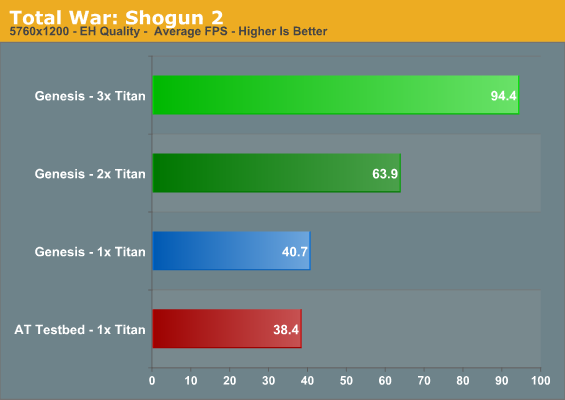
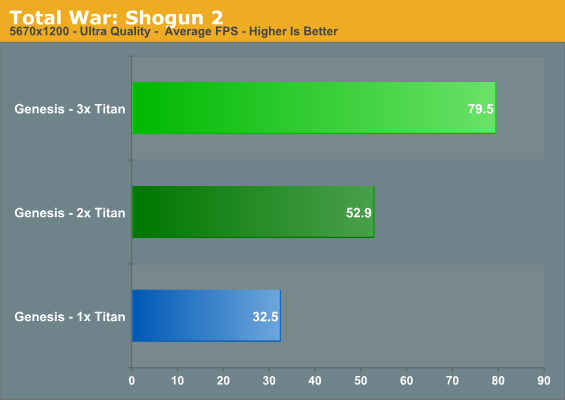
Total War 2 also scales up well with multiple Titans, though as a turn based strategy game there isn’t the same need for incredible performance here as there is with our action games. At 2560 even 1 Titan is more than enough, and at 5760 with absolutely everything cranked up, 1 Titan is still above 30fps. Still, you technically need 3 Titans to get ahead of 60fps. Oddly enough, at times the gains from a 3rd Titan are closer to the theoretical gains we’d expect than adding the 2nd Titan.
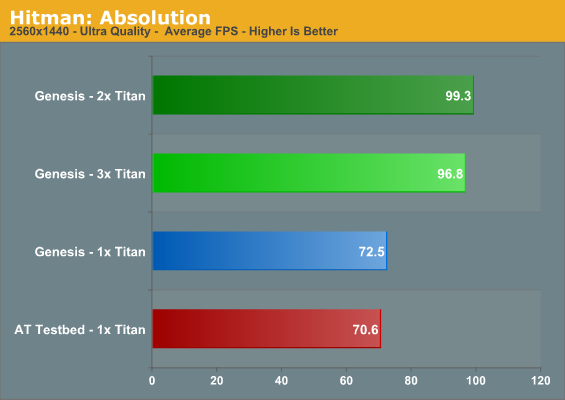
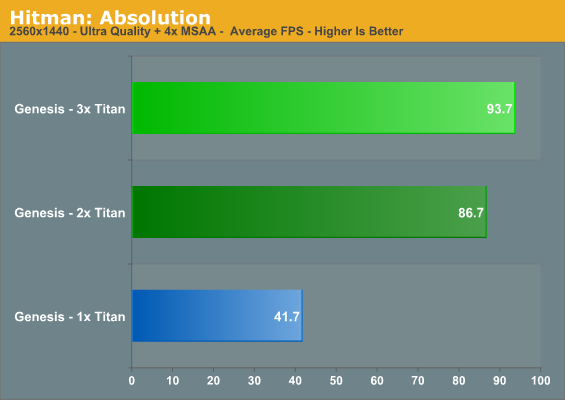
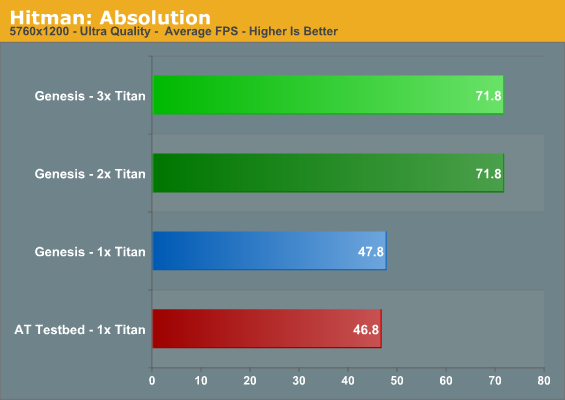
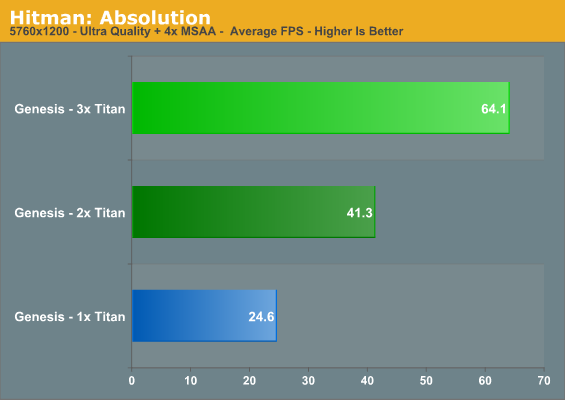
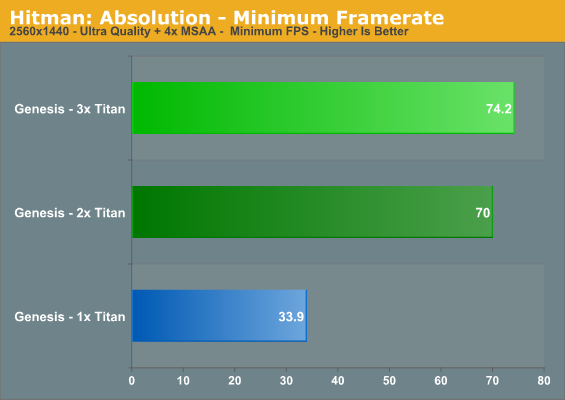
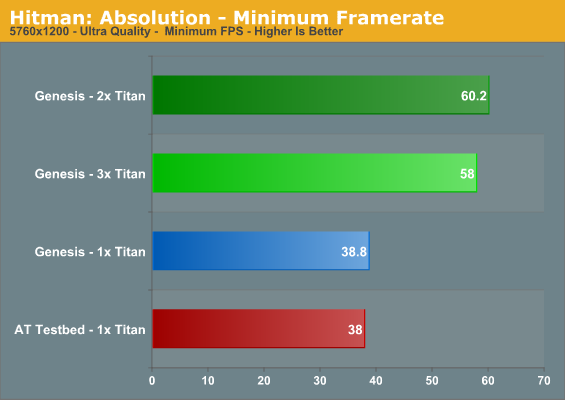
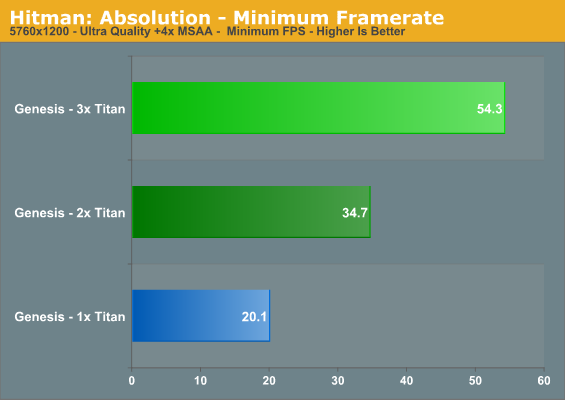
Hitman is our first good example of being CPU limited, which is a big problem any kind of multiple-Titan computer faces, including the Genesis. Thanks to the embarrassingly parallel nature of graphics rendering, the GPU side of the equation gets faster at a much greater rate than the CPUs feeding those GPUs, so it’s easy to get CPU bottlenecked, and even easier when dealing with multiple GPUs. Our in-game experience isn’t quite the CPU limited for the most part, but especially at lower resolutions the performance it’s hard to feed multiple Titans.
Overall anything short of 5760 with 4x MSAA fails to make a 3rd Titan worthwhile. On the other hand, you do need at least 2 Titans to handle MSAA even at 2560, with the 3rd making itself felt at 5760. So there is a use for 3 Titans even in a more CPU limited scenario, but it will require the highest resolutions with anti-aliasing, reinforcing the fact that the Genesis’ capabilities are best suited to driving a surround setup.










63 Comments
View All Comments
DanNeely - Tuesday, April 23, 2013 - link
I'd swag it at 3-4 years for a $1200 box; and two more for the $600 pricepoint.We're probably 2 die shrinks from having similar performance levels in an x70/x80 card. The first shrink will put slightly better than titan level performance down the upper mainstream die size (assuming standard doubling); the second will give a single card with double that and since 3way SLI performance is significantly less than the 3x that linear scaling assumes the 2 die shrink GPU should be in the same ballpark.
That's only 3 years out. Depending on how competitive the market is that card could be anywhere between $250 and $600ish; the lower end of that range should easily make a $1200 system; the top of it will probably be a year behind with the $600 price point needing another die shrink so 2 more years for that or 6 total.
faroguy - Tuesday, April 23, 2013 - link
NVIDIA had a demo system at GTC with 3 Titan's in it that was running Metro: Last Light. It was quite an awesome feeling to play on a system with that much power. Also, it wasn't terribly loud.Samus - Tuesday, April 23, 2013 - link
lol, ridiculous BF3 scorekrazeyivan - Tuesday, April 23, 2013 - link
If you want to see a beast system with 4 x Titans - check this link - probably the fastest 24/7 Rig aroundhttp://hardforum.com/showthread.php?t=1755071
Denithor - Tuesday, April 23, 2013 - link
Well, now that you have enough GPU power to push those games, do some core count studies and see what games are seriously benefiting from 2/4/6 cores. This would clearly show where you're being held back by CPU versus GPU.DanNeely - Tuesday, April 23, 2013 - link
Very few games are heavily threaded on the CPU today; so finding CPU bottlenecks would be about downclocking the chip not disabling cores. With the PS4 and xbox720 rumored to have 8 relatively lightweight CPU cores we probably will start seeing games able to take better advantage of the width of high end CPUs in a few years; but we're not at that point today.mapesdhs - Tuesday, April 23, 2013 - link
Ryan writes:> 1340W at the wall is over 11 amps; we’re not to the point where the Genesis
> needs a dedicated circuit, but that’s the majority of a 15 amp circuit right there.
Less than 6A where I am. ;)
Finally Edison's daft low-voltage DC-bias legacy is revealing itself. Is it possible that top-end
PC tech development may eventually become limited by the comparatively low max power
available from a US wall socket? I hope not.
Ian.
Death666Angel - Tuesday, April 23, 2013 - link
"Is it possible that top-end PC tech development may eventually become limited by the comparatively low max power available from a US wall socket? I hope not."Nope. You already have household items that use power in the thousand Watt range (vacuums, heaters, microwaves etc.), so a PC doing the same thing isn't a problem. And the drive in the PC industry is for lower power consumption overall. No one of the component vendors is pursuing 1k+ Watt PCs. It's the end manufacturers that offer that kind of power consumption beast on their own. And the few people that really need bigger PCs usually have their own circuits to run them off, along with specialized cooling solutions.
Death666Angel - Tuesday, April 23, 2013 - link
I don't understand the choice of 2 120GB SDDs (in RAID 0 nonetheless). And 4x4GB RAM looks wrong in this type of PC. If you go crazy, go crazy on everything. :DAs for the water cooling, I'd rather have another case that supports something like 200/280/360/420 radiators and at least 2 of those. This setup is not very elegant. If you go with such a case, give me an external water cooling radiator like the 1080/1260 ones or install a 480 quad one on the side of the case.
hero1 - Tuesday, April 23, 2013 - link
With that much money spent on the hardware I would expect them to have used a better case, custom one and bigger radiators to reduce the heat and noise. Poor job imo.